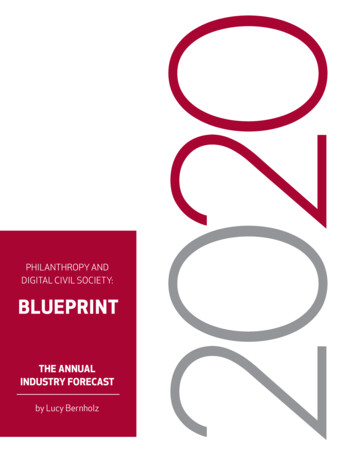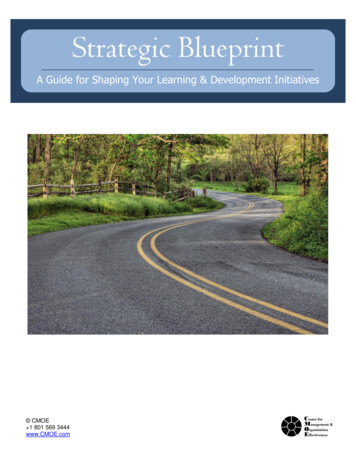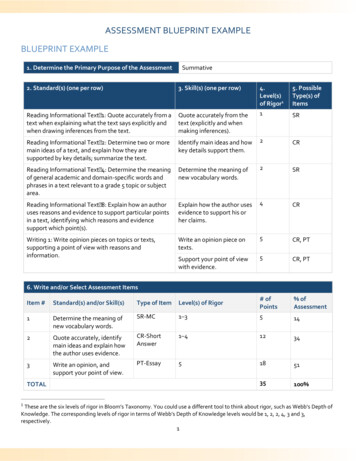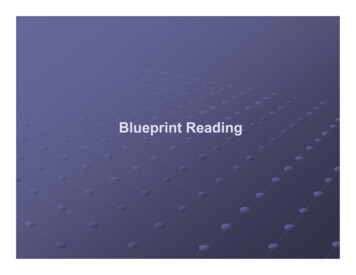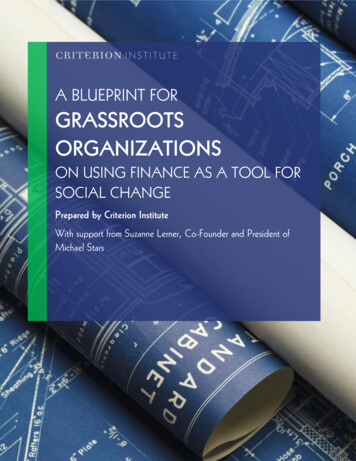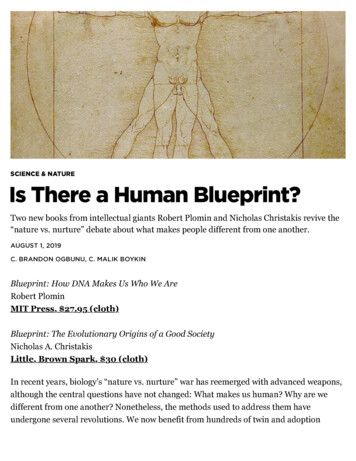
Transcription
SCIENCE & NATUREIs There a Human Blueprint?Two new books from intellectual giants Robert Plomin and Nicholas Christakis revive the“nature vs. nurture” debate about what makes people different from one another.AUGUST 1, 2019C. BRANDON OGBUNU, C. MALIK BOYKINBlueprint: How DNA Makes Us Who We AreRobert PlominMIT Press, 27.95 (cloth)Blueprint: The Evolutionary Origins of a Good SocietyNicholas A. ChristakisLittle, Brown Spark, 30 (cloth)In recent years, biology’s “nature vs. nurture” war has reemerged with advanced weapons,although the central questions have not changed: What makes us human? Why are wedifferent from one another? Nonetheless, the methods used to address them haveundergone several revolutions. We now benefit from hundreds of twin and adoption
studies, which have provided heritability estimates for dozens of characteristics relating tohuman behavior and wellness. Simultaneously, we are reaping the benefits oftechnological breakthroughs that have made it possible to screen thousands of individualsto uncover genes associated with particular traits. Thanks to this, we have been able tocorrelate genetic signatures with a growing list of physical (e.g., height, skin color),physiological (e.g., risk for type-2 diabetes, hypertension), and behavioral (e.g., risk fordepression, autism) traits. At the same time, epidemiology, psychology, and sociologycontinue to demonstrate the pliability of the human experience across populations, and wecontinue to learn more about the social forces that create vast differences in the humanexperience.Dialogue between the natural and social sciencesshould have fostered a golden age for the study ofhuman behavior.In combination, work from the natural and social sciences should have fostered a goldenage for the study of human behavior. And yet, conversations about how to explaindifferences between individuals and groups are more controversial than ever—perhaps notsurprisingly, given the political implications of any answer. Recent breakthroughs inmolecular biology have compounded the stakes. Genetic modification technologies aremoving faster than the ethical frameworks required to discuss them, and rather than waitfor a consensus to emerge about best practices, at least one rogue scientist has alreadyproduced gene-edited babies.Two new books, both titled Blueprint, attempt to rise above the fray and make normativeclaims about the role of genetics in shaping human behavior, although theirmethodologies could hardly be more different. Geneticist Robert Plomin focuses onexplaining why humans are different, while polymath physician-sociologist NicholasChristakis wants to understand why we are, in his estimation, so very similar. That thesetwo books, each authored by luminaries in their respective fields, were released withinmonths of each other heralds the zeitgeist: modern society cares deeply about the scienceunderlying who we are. And the difference in their approaches and messages reflect howcomplex the conversation has become, and how far away we are from a settled answer.
For Plomin, genetics are a fortune teller, indicating ourfate if we have the knowledge to “read” them.Plomin is a titan of behavioral psychology and chief evangelist of the gene-omnipotenceschool of thought, also known as the hereditarian school. Plomin has built his reputationthrough a quarter century of important work on behavioral genetics, mainly with twin andsibling studies. Late in 2018, he released his Blueprint, which lays out his deterministicorthodoxy and addresses the subtleties surrounding whether “it” (the fundamentalexplanatory factor for who we are and how we differ) is “all in our genes.” Plomin’sBlueprint has the makings of a modern classic as one of the most direct and unapologetictakes on the topic ever written.As an act of scientific communication, Blueprint is stellar. Direct and clear, the book attimes reads like an autobiography: not only do we learn about the work that Plomin andcolleagues have conducted, we learn also about what Plomin thinks and why he thinks it. Asingle theme runs throughout: that DNA is not only a meaningful contributor todetermining who we are, but the most stable and predictive of contributors. For Plomin,genetics are in effect a fortune teller, indicating our fate if we have the knowledge to “read”them.Plomin’s fortune-teller analogy has already been criticized, and much of the book iswritten as a kind of preemptive strike, aimed at quelling his opposition. In various ways,critiques of Plomin emphasize the importance of environmental forces—structural,experiential, and historical—on the fate of individuals and societies (this opposition issometimes pejoratively described as pushing a “blank slate” agenda). Plomin’s detractorsoften highlight the social implications of hereditarian overreach. That is, if weattribute all of our behavior to our genes, we arrive back at a kind of predestination thesis,in which we are washed of any individual responsibility for ours actions. This is no lessworrying than the way that genetic determinism undermines social or structuralexplanations for inequalities. Indeed, this is the most radioactive of hereditarian ideas,with implications on gender diversity in the natural sciences, class- and race-stratified
differences in standardized test scores, and even sentencing in the criminal justicesystem.Criticism has not humbled Plomin; in many ways, Blueprint finds him doubling down onhis positions—at times with peculiar results. In an effort to defend the determinism ofgenes, the effect is at times the opposite. For example, he asserts that “heritability of bodyweight is greater in wealthier countries such as the US than in poorer countries such asAlbania or Nicaragua.” This goes by quickly, but the idea here is a rather radical one: in anutrient-poor environment, genes associated with high body weight are going to be lesspredictive than they would be in a nutrient-rich environment. Because the DNA-destiny ofgenes that confer high weight must have certain nutrients, provided by a certainenvironment, in order to manifest. The implication of this seems lost on Plomin: DNAdoesn’t operate in isolation, but only as a function of the environment in which it (theindividual person in this case) exists. With this in mind, we can ask Plomin: How good of afortune teller is DNA if it can read the same palm but offer different fortunes depending onthe GDP of the country the palm calls home? If this is the most one can say for it, thenDNA doesn’t function as a “blueprint” for anything.How good of a fortune teller is DNA if it can read thesame palm but offer different fortunes depending onthe GDP of the country the palm calls home?Plomin encounters an analogous dilemma in his discussion of the effect of environment onphenotypes: “Genetic research shows that non-shared environmental influences are notonly unsystematic in the sense that they are mostly a matter of chance, they are alsolargely unstable, that is inconsistent over time.” It strikes us as peculiarly incurious todecide that all aspects of nature that undermine DNA’s predictive powers are merely a“matter of chance,” “unsystematic,” and “unstable.” It is in effect to say that whatevercannot be studied with Plomin’s particular methods is no more than statistical noise. Aricher alternative is that the world is not just an obstacle to DNA doing its job. In reality,DNA has no choice but to interact with the world and has never existed apart from it.Consequently, whatever predictive powers DNA has are always about the world: full ofinteractions, circumstances, contingencies, and context. This interpretation isn’t “blankstate” ideology—it’s biology.
And this seems to be the direction that the evidence is mounting. Recent large-scalepopulation studies have shown that genetic signatures for several traits (physical,physiological, behavioral) are not even consistent in homogenous populations spreadacross a wide terrain, such as in Finland. In addition, most of the data that Plomin cites isdrawn largely from people of European descent, but most of the world is non-European ormixed. If the data reflected this human diversity, it would certainly shift and perhaps fullyundermine our current picture of heritability. For diseases such as type 2 diabetes, we arealready finding that the genetic story is a mess: signatures exist, but can differ fromindividual case to individual case.These findings reflect a biological real world more complicated—and frankly morefascinating—than the one Plomin champions.Despite the far reach of the debate surrounding Plomin’s hereditarianism, genetics is butone method used to generate an increasingly intricate picture of human nature. Anothermeans through which scientists establish essential rules of human biology comes from afocus on the commonalities and differences between cultures. Using this approach, onecan impute basic properties of human society, and, by extension, of the individuals thatcompose it.The regressive arm of this argument resembles its cousin in genetics: differences betweengroups imply inequity, and inequity implies a hierarchy. The more progressive end of theculture-comparison school, however, uses features present across societies as evidence foruniversality, even equity. While large observable differences between human societies arepresent and consequential, few reveal anything essential (and perhaps none revealanything immutable) about any group. That soccer is more popular in Uruguay thanCuraçao might be important. The notion that soccer’s popularity speaks to somethingessential about the people of Uruguay or Curaçao is made of the same corrupted stuff thatwe find in ethnocentrism, nationalism, and fascism.In contrast to Plomin, Christakis argues that culturerather than genetics is responsible for the differences
between societies.Christakis’s Blueprint contends that similarities between cultures can teach us about whatit means to be human. Christakis traverses political science, anthropology, network theory,and other disciplines to piece together his central argument: human societies haveessential features that can tell us about how we evolved. In contrast to Plomin, Christakisargues that culture rather than genetics is responsible for the differences betweensocieties:[But] genes surely explain very little of the variation among cultural groups in the long lists of traitspropounded by anthropologists. There are no genes for surgery or idolatry that explain why somesocieties cut people open or make images of gods. Such variation is due to culture.When discussing societies with drastically different marital structures—such as the Hadzaof Tanzania and the Turkana of western Kenya—Christakis doesn’t care why they aredifferent, but rather finds in them evidence that many of the central characteristics ofhuman societies are global, even when refracted through cultural specifics. Why do theHadza prefer monogamy and the Turkana polygyny? How did it get that way? That’s aquestion for a different book.Christakis doesn’t steer entirely clear from controversy, however. The book’s penultimatechapter describes why culture is critical to human progress, how cultural evolution canoperate like biological evolution, and how culture may influence biology. In this last area,Christakis’s Blueprint takes its own Plomin-like leaps. It begins by outlining several safeexamples of how cultural changes can drive biological evolution: the ability to digestlactose in response to a pastoral lifestyle (because it was beneficial in societies with milkproducing animals), and the sickle cell trait evolving as a response to yam domestication(because yam fields are breeding grounds for mosquitoes). Christakis then descends intospeculative terrain, offering that humans might be getting smarter because ofurbanization: “For instance, as a species, we may be getting smarter because we live incities, where urban culture is getting ever more complex, stimulating, and demanding.”This is a fun suggestion, if only because it runs counter to the almost ubiquitous (ifunsubstantiated) fear that the fraying of meaningful social bonds in cities and via social
media is making us all dumber. But it’s also unclear what it says about Christakis’s view ofcultures that are not largely urban: Is the intelligence of urban humans leaving them in thedust? That doesn’t seem like an argument Christakis would want to make, but the lattersupposition seems inseparable from the former.Christakis offers that humans might be getting smarterbecause of urbanization, but it is unclear what he thenthinks of cultures that are not largely urban.An even larger leap follows, with Christakis suggesting that large, organized religionsmight have selected for brains predisposed to believe their truth claims. The problemswith this supposition are fairly obvious (and Christakis almost certainly understandsthem): the success of global religions such as Christianity and Islam among the colonizedand subaltern could not be the result of genetic priming. And it seems both impossible andunethical to give an account of their success without attending to geopolitics and power.Or, in a quite different vein, what does this theory offer to explain the rise of atheism? Saiddifferently, it appears that people everywhere have the (biological) capacity to readilyadopt religion in some contexts and give it up entirely in others.As different as Plomin’s and Christakis’s Blueprints are, both are vulnerable totroublesome overreach. Slight perversions of Plomin’s arguments are so directly alliedwith classical scientific racism—that ethnic groups are not only essentially different butcan be ranked—that he mostly steers clear of the issue in his work, and when he doesengage, dismisses the notion that his findings explain differences between groups.However, while he insists that his work should not be extended to justify bigotry, merelysaying so is not itself exculpatory if a reasonable extension of his theories points directlythere. If we believe that genetics explains why classroom A outperforms classroom B, thatis quite enough: the justifications to treat the two groups of children “differently”—withdisinvestment in classroom B, for example—follow automatically and without a moralcheck (after all, we’re just “following the data”).
It is possible to believe that genes do the heavy liftingwith regard to why humans are different whileacknowledging that history and context profoundlyinfluence how society is structured.In fairness, Plomin himself helps us understand (perhaps unintentionally) why theseinterpretations are misguided. In his Blueprint, he reminds the reader that a key feature ofheritability is that it “describes what is but does not predict what could be.” For example,the heritability of schizophrenia may reveal more about the individuals in which thosemeasurements were taken than it does the average person. And even more, thisheritability says little for what we can do as a society to influence how any particularschizophrenic fate plays out. Tomorrow might yield a discovery that tweaks thisheritability: a new drug could lower it, a famine could increase it. That a trait may bedriven by genes doesn’t mean that culture or human ingenuity can’t tweak the strength ofthat relationship tomorrow.Christakis’s Blueprint has a less direct connection to discrimination, but the substrate isstill present: even if we don’t believe that the Turkana and Hadza are innately different, wemight rank their societies based on whose culture fits our personal palette. We can replace“genes” with “culture” and we can still have the same old bigotry.It is important to note, however, that characterizing the central ideas in either book (andtheir putative schools of thought) as intrinsically bigoted would be imprecise: it is possibleto believe that genes do a lot of the heavy lifting with regard to why humans are different—physically, physiologically, psychologically—while fully acknowledging that history andcontext can profoundly influence how society is structured. Similarly, we can appreciatethe differences between societies—how they live, love, and build relationships—without areflexive value judgement on which ones are “better.”The study of humans and how we differ should not have cosmic consequences, but in2019, it does: essentialist racism and xenophobia have new life as a political instrument inthe West. And this is why the work of Plomin, Christakis, and many others matters. Wemust fully appreciate the many powers of DNA and admit that context and culture—past,present, and future—can transcend these powers, and craft the multiverse that defines the
experience of being human.While we have you.we need your help. You might have noticed the absence of paywalls at Boston Review. Weare committed to staying free for all our readers. Now we are going one step further tobecome completely ad-free. This means you will always be able to read us without roadblocksor barriers to entry. It also means that we count on you, our readers, for support. If you likewhat you read here, help us keep it free for everyone by making a donation. Noamount is too small. You will be helping us cultivate a public sphere that honors pluralism ofthought for a diverse and discerning public.SUPPORT BOSTON REVIEWFacebookMore In Science & NatureTwitterEmailMore
Programming My ChildDefensible SpaceDAVID AUERBACHJESSIE KINDIGPrinting Note: For best printing results try turning on any optionsyour web browser's print dialog makes available for printingbackgrounds and background graphics.
it begins by outlining several safe examples of how cultural changes can drive biological evolution: the ability to digest lactose in response to a pastoral lifestyle (because it was beneficial in societies with milk- producing animals), and the sickle cell trait evolving as a response to yam domestication (because yam fields are breeding grounds


